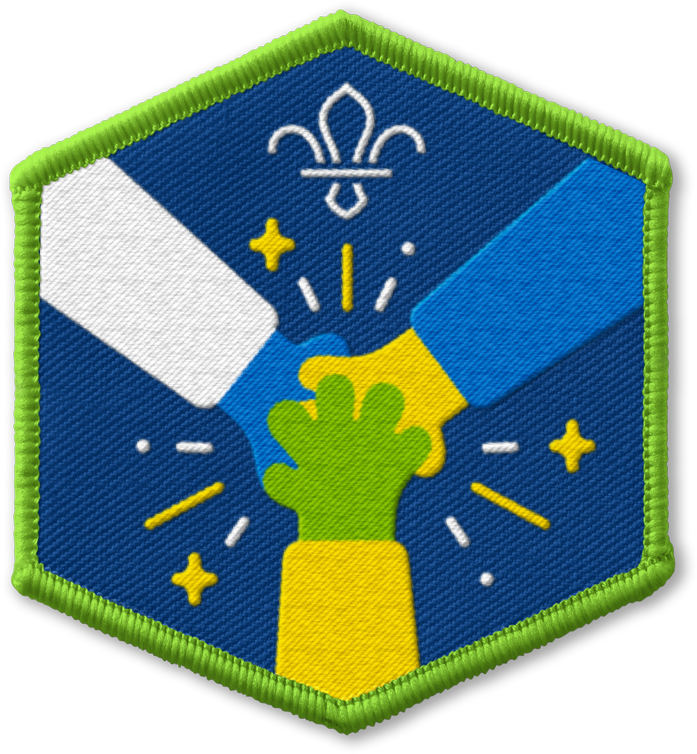
Broken telephone
Before you begin
- Use the safety checklist to help you plan and risk assess your activity. There's also more guidance to help you carry out your risk assessment, including examples. Don’t forget to make sure all young people and adults involved in the activity know how to take part safely.
- Make sure you’ll have enough adult helpers. You may need some parents and carers to help if you’re short on helpers.
- You might want to think of some appropriate messages for your group to use.
Play the game
- Everyone sits in a circle. Explain that you’re going to play a game called Broken Telephone.
- An adult volunteer or Young Leader needs to think of an appropriate message to secretly pass around the circle.
- The adult volunteer or Young Leader then whispers the message to the next person in the circle.
- The whispered message is passed from person-to-person.
- The last person announces to the group the message they heard. The message may have changed as it's been passed along, providing a fun laugh for all!
- The adult volunteer or young leader should then choose someone else to select the next message.
- To make it more competitive, you could play this in two teams and, with the same message being given for both teams, see who gets the most accurate message down their line.
Playing this game with movements, instead of voices
- You can also play this by passing a sequence of actions, such as patting your head, turning round and rubbing your tummy, instead of a message.
- Everyone should stand in two lines, with everyone facing the same way, so everyone can see each other’s backs.
- The first person should think of a sequence and tap the next person on the shoulder to turn around when they’re ready. They could also say their name.
- The first person should show their sequence of movements to the second person and turn back around.
- The second person should then turn around, tap the third person on the shoulder to tell them to turn around and pass on the sequence of actions, and so on, until the sequence reaches the end of the line.
- The last person should show the sequence to the group that they were shown. The movements may have changed as it's been passed along, providing a fun laugh for all!
- The adult volunteer or young leader should then choose someone else to select the next sequence of movements.
Reflection
This game was all about having fun, clear communication and remembering things. People also had to try to listen and remember what had been said, as well as use your imagination to come up with a new message.
Think about how you remembered the message. How did you listen to the people before you? Did you have a method for remembering the phrase? Did anything work well and help you? What would you do differently if we played again?
You had to clearly communicate with the next person in the line. How did you make sure you clearly passed the message on, so they could hear it and understand what was being said? Did you talk quickly or slowly?
You had to use your imagination to create a message. How did you choose what to add on next? Did you look around the room? Did you choose something easy or something harder to try to trick people?
Safety
All activities must be safely managed. You must complete a thorough risk assessment and take appropriate steps to reduce risk. Use the safety checklist to help you plan and risk assess your activity. Always get approval for the activity, and have suitable supervision and an InTouch process.
- Active games
The game area should be free of hazards. Explain the rules of the game clearly and have a clear way to communicate that the game must stop when needed. Take a look at our guidance on running active games safely.
You can change the level of the difficulty of this challenge by making it a longer or shorter message.
- This game can be played sitting or standing – whichever way works best for everyone.
- Take time and have patience while telling everyone what to do. Give short instructions clearly and concisely. If you need to, pause, then repeat the same instruction using the same words. You could have visual resources to explain the game or a printed copy of the instructions for anyone who may need them.
- People who struggle with making choices could find all the options of deciding on a message. They might need extra support or to work with a young leader/volunteer to be able to choose what they say. You could have a list of ideas for people to choose from, or an adult volunteer could select the message or sequence.
- You could have a practice round of the game to make sure everyone knows what they’re doing. Let young people help explain to each other what to do, too.
- Make sure any individual with hearing loss can clearly see the person speaking, as they may find it helpful to read lips or body language. You could play the sequence version of this game. You could also have people further spread out in the circle, so the message can be spoken face-to-face, rather than whispered into someone’s ear, without anyone overhearing.
All Scout activities should be inclusive and accessible.
You could play this over a wider area and spread teams out to get the message from one side of the field to the other. You could also create ‘cup and string’ telephones and let people use these to pass the message on.
Try the game Silent sprint for a BSL finger-spelling version of this game.
Let young people create the message.


